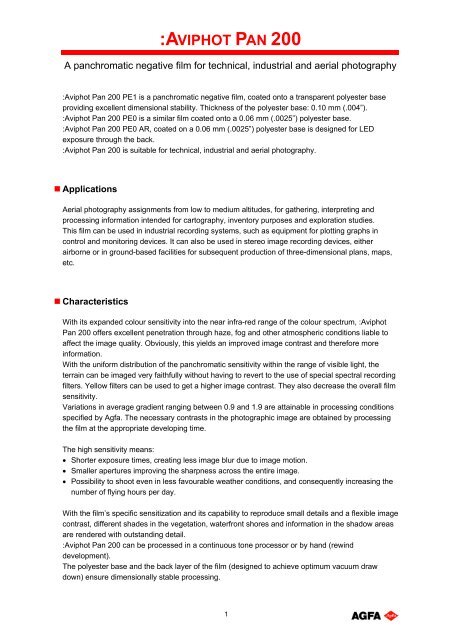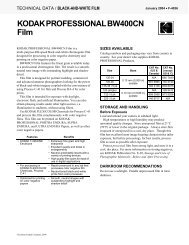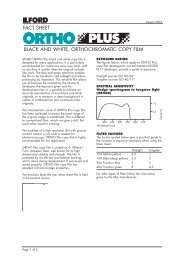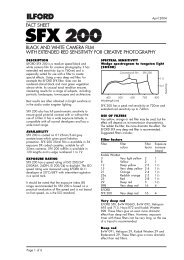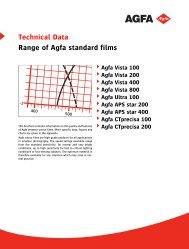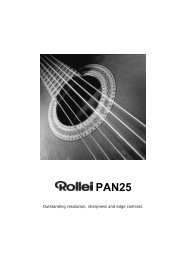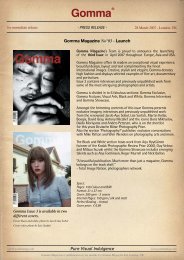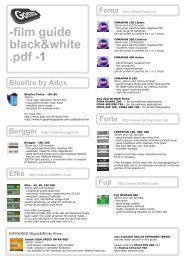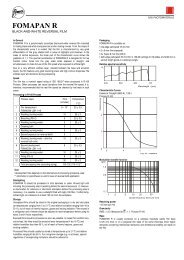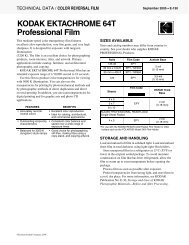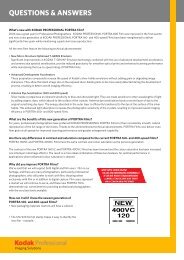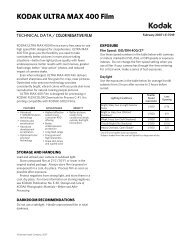:AVIPHOT PAN 200 - Agfa
:AVIPHOT PAN 200 - Agfa
:AVIPHOT PAN 200 - Agfa
Create successful ePaper yourself
Turn your PDF publications into a flip-book with our unique Google optimized e-Paper software.
:<strong>AVIPHOT</strong> <strong>PAN</strong> <strong>200</strong><br />
A panchromatic negative film for technical, industrial and aerial photography<br />
:Aviphot Pan <strong>200</strong> PE1 is a panchromatic negative film, coated onto a transparent polyester base<br />
providing excellent dimensional stability. Thickness of the polyester base: 0.10 mm (.004”).<br />
:Aviphot Pan <strong>200</strong> PE0 is a similar film coated onto a 0.06 mm (.0025”) polyester base.<br />
:Aviphot Pan <strong>200</strong> PE0 AR, coated on a 0.06 mm (.0025”) polyester base is designed for LED<br />
exposure through the back.<br />
:Aviphot Pan <strong>200</strong> is suitable for technical, industrial and aerial photography.<br />
• Applications<br />
Aerial photography assignments from low to medium altitudes, for gathering, interpreting and<br />
processing information intended for cartography, inventory purposes and exploration studies.<br />
This film can be used in industrial recording systems, such as equipment for plotting graphs in<br />
control and monitoring devices. It can also be used in stereo image recording devices, either<br />
airborne or in ground-based facilities for subsequent production of three-dimensional plans, maps,<br />
etc.<br />
• Characteristics<br />
With its expanded colour sensitivity into the near infra-red range of the colour spectrum, :Aviphot<br />
Pan <strong>200</strong> offers excellent penetration through haze, fog and other atmospheric conditions liable to<br />
affect the image quality. Obviously, this yields an improved image contrast and therefore more<br />
information.<br />
With the uniform distribution of the panchromatic sensitivity within the range of visible light, the<br />
terrain can be imaged very faithfully without having to revert to the use of special spectral recording<br />
filters. Yellow filters can be used to get a higher image contrast. They also decrease the overall film<br />
sensitivity.<br />
Variations in average gradient ranging between 0.9 and 1.9 are attainable in processing conditions<br />
specified by <strong>Agfa</strong>. The necessary contrasts in the photographic image are obtained by processing<br />
the film at the appropriate developing time.<br />
The high sensitivity means:<br />
• Shorter exposure times, creating less image blur due to image motion.<br />
• Smaller apertures improving the sharpness across the entire image.<br />
• Possibility to shoot even in less favourable weather conditions, and consequently increasing the<br />
number of flying hours per day.<br />
With the film’s specific sensitization and its capability to reproduce small details and a flexible image<br />
contrast, different shades in the vegetation, waterfront shores and information in the shadow areas<br />
are rendered with outstanding detail.<br />
:Aviphot Pan <strong>200</strong> can be processed in a continuous tone processor or by hand (rewind<br />
development).<br />
The polyester base and the back layer of the film (designed to achieve optimum vacuum draw<br />
down) ensure dimensionally stable processing.<br />
1
• Photographic data<br />
Colour sensitivity<br />
Panchromatic, up to 750 nm.<br />
Absolute spectral sensitivity<br />
Sensitivity is reciprocal of the esposure (mJ/m 2 ) required to produce the indicated density.<br />
Processed in :Gevatone 66, in G 74 c developer at 30 °C, for 42 seconds.<br />
Resolution<br />
According to ANSI PH 2.33 standard:<br />
TOC (Target Object Contrast) 1000:1= 181 lp/mm or 362 dots/mm.<br />
TOC 1.6:1 = 51 lp/mm or 102 dots/mm.<br />
2
RMS granularity<br />
Measured at 50µm spot size.<br />
Processed in :Gevatone 66, in G 74 c developer at 30 °C and gamma = 1.20.<br />
Photographic modulation transfer function<br />
3
• Production guidelines<br />
Darkroom lighting<br />
:Aviphot Pan <strong>200</strong> has to be handled in complete darkness.<br />
Exposure<br />
The film speed can vary according to processing. :Aviphot Pan <strong>200</strong> can be exposed as a 125 to<br />
250 ASA film. Consequently, it can be used with all classic aerial recording cameras (ZI, LH, Vinten,<br />
Recon Optical, ...). Working with EAFS/ISO.A exposure values also yields good results, although<br />
these values differ for every processor and developer.<br />
Exposure depends on<br />
• the required image contrast;<br />
• the light reflected from the earth;<br />
• altitude and speed of the aircraft.<br />
Filter factors<br />
If filters are used, the exposure time should be increased by a filter factor.<br />
With filter L 453<br />
yellow<br />
L 519<br />
orange-yellow<br />
L 599<br />
red<br />
Filter factor 1.5 1.8 3.0 4.0<br />
L 622<br />
red<br />
Absorption curves of the filters used:<br />
If the filters are supplied by the manufacturers of aerial photography recording cameras, we<br />
recommend to follow the filter factors supplied by them.<br />
4
Processing<br />
:Aviphot Pan <strong>200</strong> PE1/PE0 can be processed either in a continuous-tone processor, or by hand if<br />
there is no processor available.<br />
Automatic processing in :Gevatone 66, in G 74 c developer<br />
Optimum quality can be attained at 20 to 70 seconds of developing time, depending on the required<br />
gradation and sensitivity.<br />
Main sensitometric curves<br />
• Characteristic curves<br />
5
• Exposure/time curves<br />
EAFS: Exposed using a 5800K xenon flash. Daylight measured 400 nm to 740 nm.<br />
ASA: Exposed using a 5800 K xenon flash. Daylight measured with a visual filter.<br />
• Average gradient/time curve<br />
6
• Fog/time curve<br />
Rewind processing<br />
Example: working method using a Zeiss FE rewind unit.<br />
Wind the exposed film on the rewind frame. Rewind the film once by hand in water at 20 °C. Only<br />
afterwards you can start to develop the film.<br />
Developer: G 74 c. The optimum developing time can be derived from the average gradient/time<br />
and exposure/time curves.<br />
Rapid fixer: G 333 c or :Vfix, with 12 ml of :Aditan hardening agent added for every litre of fixer. At<br />
least 6 passages required (1 passage at 76 m and 38 m = 2.5 minutes).<br />
Rinsing: 8 passages in running water.<br />
Drying: Add 1 ml of :Agepon per litre of final wash water, to ensure drying of the film.<br />
7
Rewind development in G 74 c<br />
Mixing solution: 1.5 l of part A + 10 l water + 1.5 l of part B + 0.335 l of G 74 s (starter) + 16.7 l<br />
water.<br />
Developer temperature: 20 °C.<br />
The most important sensitometric curves for 240 mm x 76 m rolls:<br />
• Characteristic curves<br />
8
• Exposure/time curves<br />
• Average gradient/time curves<br />
• Fog/time curve<br />
9
• Assortment<br />
Standard sizes*<br />
Size<br />
Spool/Winding/Perforation Order code<br />
240 mm x 76 m 9 1/2 in x 249 ft AH897 – EI – NP 3DEPF<br />
240 mm x 152 m 9 1/2 in x 500 ft AM897 – EI – NP 3DEQH<br />
* For all other sizes, please contact your local <strong>Agfa</strong> representative.<br />
:Aviphot Pan <strong>200</strong> PE0 and :Aviphot Pan <strong>200</strong> PE0-AR are also available.<br />
Subject to change without prior notice.<br />
AGFA, the <strong>Agfa</strong>-Rhombus, :Aviphot and :Gevatone are trademarks of <strong>Agfa</strong>-Gevaert Belgium and Germany.<br />
© <strong>200</strong>4 <strong>Agfa</strong>-Gevaert N.V., B2640 Mortsel-Belgium.<br />
February <strong>200</strong>4<br />
10


